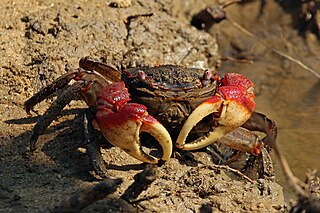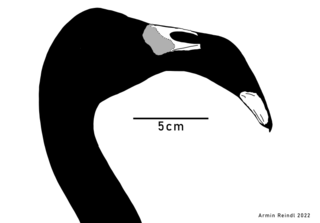
Grebes are aquatic diving birds in the order Podicipediformes. Grebes are widely distributed freshwater birds, with some species also found in marine habitats during migration and winter. Most grebes fly, although some flightless species exist, most notably in stable lakes. The order contains a single family, the Podicipedidae, which includes 22 species in six extant genera.

The Lac de Guiers or Lake Guiers is a lake in northern Senegal, south of the city of Richard-Toll and in the Louga and Saint-Louis regions. It is a chief source of fresh water for the city of Dakar, hundreds of kilometers to the south-west, through underground pipes.

Flamingos or flamingoes are a type of wading bird in the family Phoenicopteridae, which is the only extant family in the order Phoenicopteriformes. There are four flamingo species distributed throughout the Americas, and two species native to Afro-Eurasia.

Phoenicopterus is a genus of birds in the flamingo family Phoenicopteridae.

The lesser flamingo is a species of flamingo occurring in sub-Saharan Africa and western India. Birds are occasionally reported from further north, but these are generally considered vagrants.

Yangudi Rassa National Park is a national park in Ethiopia located in Afar Region.

Palaelodus is an extinct genus of bird of the Palaelodidae family, distantly related to flamingos. They were slender birds with long, thin legs and a long neck resembling their modern relatives, but likely lived very different livestyles. They had straight, conical beaks not suited for filter feeding and legs showing some similarities to grebes. Their precise lifestyle is disputed, with researchers in the past suggesting they may have been divers, while more recent research suggests they may have used their stiff toes as paddles for swimming while feeding on insect larvae and snails. This behavior may have been key in later phoenicopteriforms developing filterfeeding bills. The genus includes between five and eight species and is found across Europe, Australia, New Zealand, Asia and possibly South America. However some argue that most of the taxa named from Europe simply represent differently sized individuals of one single species. Palaelodus was most abundant during the Late Oligocene to Middle Miocene periods, but isolated remains from Australia indicate that the genus, or at least a relative, survived until the Pleistocene.

Menabe Antimena is a protected area in Menabe region of western Madagascar. It belongs to the municipalities of Tsimafana, Beroboka, Bemanonga, Belon'i Tsiribihina, and Tsaraotana.
Phoeniconotius is an extinct genus of flamingo that lived in Australia from the late Oligocene to the early Miocene. Unlike modern flamingos and the contemporary Phoenicopterus novaehollandiae, it was likely less well adapted for swimming and deep water wading. Phoeniconotius was a robust flamingo with bones more massive than those of the modern greater flamingo. Only a single species is recognized, Phoeniconotius eyrensis.

Palaelodidae is a family of extinct birds in the group Phoenicopteriformes, which today is represented only by the flamingos. They were widespread during the Neogene, with fossil remains found on all continents other than Antarctica. The oldest remains referred to this group appeared in the fossil record during the Oligocene in Egypt and Belgium, before palaelodids reached their peak diversity during the Miocene. Following this the group declined in the early Pliocene before going extinct on most continents. However, remains found near Cooper Creek in the Lake Eyre Basin indicate that palaelodids managed to survive in Australia until the Pleistocene. Currently three genera are recognized by scientists: Adelalopus, Palaelodus and Megapaloelodus. Most fossil remains stem from Europe and have been assigned to the type species, Palaelodus ambiguus. Due to the fragmentary nature of most of these species, little is known about their ecology. They appear to have preferred brackish lakes and lagoons. Palaelodus has previously been thought to be a wader or diver, but recent research indicates that they were better suited for swimming and possibly fed on insect larvae and other aquatic invertebrates. At least Megapaloelodus appears to have adaptations for "locking" their legs in a standing position.

The Southern Africa mangroves are mangrove ecoregion on the Mozambique's southernmost coast and the eastern coast of South Africa.
Phoenicopterus minutus is an extinct species of flamingo which inhabited California during the Late Pleistocene. It was originally discovered in San Bernardino County, California in the Lake Manix beds, where it coexisted with a second, larger flamingo species.
Leptoptilos falconeri is an extinct species of large-bodied stork that existed during the Pliocene, having persisted until just over 2.58 million years ago. Although not the oldest fossil species of the genus Leptoptilos it was the first fossil species of the genus to be described. Furthermore, it was the largest known species of stork ever and amongst the tallest and heaviest flying birds known to have existed, having reached at least 2 m in height.
Harrisonavis is an extinct genus of flamingo that lived during the Late Oligocene and Early Miocene periods in what is now France. Despite being one of the oldest known members of the flamingo family, it already shows a skull remarkably similar to that of the modern greater flamingo. Although generally similar, it subtly differs in the curvature of the bill and the size of the ventral keel of the maxilla, both signs that Harrisonavis was not yet as adapted towards filter feeding as modern species are. Harrisonavis inhabited brackish lakes alongside the more basal Palaelodidae. It contains the single species Harrisonavis croizeti, first described in 1852.
Phoeniconaias siamensis is an extinct species of flamingo that lived in northern Thailand during the Miocene period. Its closest living relative is the lesser flamingo.

Leakeyornis is an extinct genus of flamingo from the early to middle Miocene of Kenya, primarily in the area of modern day Lake Victoria. Initially described as a species of Phoenicopterus based on an incomplete skull and various limb bones, it was later found to show a mixture of traits found across modern flamingo genera and subsequently placed in its own genus. It contains a single species, Leakeyornis aethiopicus.
Phoenicopterus novaehollandiae is an extinct species of flamingo from the late Oligocene or early Miocene Etadunna Formation of Australia. It was a large species similar in size to large specimens of the modern greater flamingo, but differed by likely having had a much better developed hallux which is typically reduced or absent in modern flamingos.
Phoenicopterus floridanus is an extinct species of flamingo that lived during the Pliocene in what is now Florida and potentially North Carolina.
Phoeniconaias proeses is an extinct species of flamingo from the Pliocene of Australia. Fossil material was described under several names including Ocyplanus proeses and Phoeniconaias gracilis, which were eventually found to be synonymous. Only material from the Tirari Formation has been dated, while most other material lacks precise information on its age. P. proeses was one of the smallest species of flamingo, smaller than the modern lesser flamingo which it may be related to.

Xenorhynchopsis is an extinct genus of flamingo from the Pliocene to Pleistocene Lake Eyre basin of Australia. Initially described as species of stork, the two known Xenorhynchopsis species are vastly different in size. X. minor is the older and small of the two species, ranging from the Pliocene to Pleistocene and being described as having reached a size smaller than that of the lesser flamingo. X. tibialis meanwhile appears to have been restricted to Pleistocene strata and was notably bigger, being counted as one of the biggest known flamingos in the fossil record.














